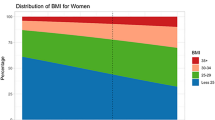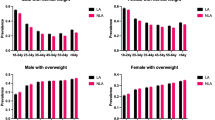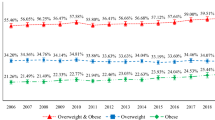Abstract
OBJECTIVE: To examine body mass index (BMI) and the proportion overweight and obese among adults age 18–59 in the six largest Asian American ethnic groups (Chinese, Filipino, Asian Indian, Japanese, Korean, Vietnamese), and investigate whether BMI varies by nativity (foreign- vs native-born), years in US, or socioeconomic status.
DESIGN: Cross-sectional interview data were pooled from the 1992–1995 National Health Interview Survey (NHIS).
SUBJECTS: 254,153 persons aged 18–59 included in the 1992–1995 NHIS. Sample sizes range from 816 to 1940 for each of six Asian American ethnic groups.
MEASUREMENTS: Self-reported height and weight used to calculate BMI and classify individuals as overweight (BMI≥25 kg/m2) or obese (BMI≥30 kg/m2), age, sex, years in the US, household income and household size.
RESULTS: For men, the percentage overweight ranges from 17% of Vietnamese to 42% of Japanese, while the total male population is 57% overweight. For women, the percentage overweight ranges from 9% of Vietnamese and Chinese to 25% of Asian Indians, while the total female population is 38% overweight. The percentage of Asian Americans classified as obese is very low. Adjusted for age and ethnicity, the odds ratio for obese is 3.5 for women and 4.0 for men for US - vs foreign-born. Among the foreign-born, more years in the US is associated with higher risk of being overweight or obese. The association between household income for women is similar for US-born Asian Americans and Whites and Blacks, but is much weaker for foreign-born Asian Americans.
CONCLUSIONS: While these data find low proportions of Asian Americans overweight at present, they also imply the proportion will increase with more US-born Asian Americans and longer duration in the US.
This is a preview of subscription content, access via your institution
Access options
Subscribe to this journal
Receive 12 print issues and online access
$259.00 per year
only $21.58 per issue
Buy this article
- Purchase on Springer Link
- Instant access to full article PDF
Prices may be subject to local taxes which are calculated during checkout


Similar content being viewed by others
References
Flegal KM, Carroll MD, Kuczmarski RJ, Johnson CL . Overweight and obesity in the United States: prevalence and trends, 1960–1994 Int J Obes Relat Metab Disord 1998 22: 39–47.
Peters KD, Kochanek KD, Murphy SL . Deaths: final data for 1996. National vital statistics reports; 47(9) National Center for Health Statistics: Hyattsville, MD 1998.
National Center for Health Statistics web site, 20 September 1999http://www.cdc.gov/nchswww/products/catalogs/subject/nhis/nhis.htm#description1.
US Department of Health and Human Services . National Center for Health Statistics, Hyattsville, MD. National Health Interview Survey, 1992 Inter-university Consortium for Political and Social Research: Ann Arbor, MI 1994.
US Department of Health and Human Services . National Center for Health Statistics, Hyattsville, MD. National Health Interview Survey, 1993 Inter-university Consortium for Political and Social Research: Ann Arbor, MI 1995.
US Department of Health and Human Services . National Center for Health Statistics, Hyattsville, MD. National Health Interview Survey, 1994 Inter-university Consortium for Political and Social Research: Ann Arbor, MI 1996.
US Department of Health and Human Services . National Center for Health Statistics, Hyattsville, MD. National Health Interview Survey, 1995 Inter-university Consortium for Political and Social Research: Ann Arbor, MI 1997.
Graubard BI, Korn EL . Survey inference for subpopulations Am J Epidemiol 1996 144: 102–106.
Barringer HR, Gardner RW, Levin MJ . Asians and Pacific Islanders in the United States. (The Population of the United States in the 1980s) NYL Russell Sage Foundation: New York, 1993.
Willett W . Nutritional Epidemiology, 2nd edn New York: Oxford University Press 1998, p 247.
Palta M, Prineas RJ, Berman R, Hannan P . Comparison of self-reported and measured height and weight Am J Epidemiol 1982 115: 223–230.
Stewart AW, Jackson RT, Ford MA, Beaglehole R . Underestimation of relative weight by use of self-reported height and weight Am J Epidemiol 1987 125: 122–126.
Hill A, Roberts J . Body mass index: a comparison between self-reported and measured height and weight J Public Health Med 1998 20: 206–210.
Klatsky AL, Armstrong MA . Cardiovascular risk factors among Asian Americans living in northern California Am J Public Health 1991 81: 1423–1428.
Popkin BM, Udry JR . Adolescent obesity increases significantly in second and third generation U.S. Immigrants: the National Longitudinal Study of Adolescent Health J Nutr 1998 128: 701–706.
Sobal J, Stunkard AJ . Socioeconomic status and obesity: a review of the literature Psychol Bull 1989 105: 260–275.
Stunkard AJ . Socioeconomic status and obesity Ciba Found Symp 1996 201: 174–187.
Gallagher D, Visser M, Sepúlveda D, Pierson RN, Harris T, Heymsfield SB . How useful is body mass index for comparison of body fatness across age, sex and ethnic groups? Am J Epidemiol 1996 143: 228–239.
Wang J, Thornton JC, Russell M, Burastero S, Heymsfield S, Pierson RN Jr . Asians have lower body mass index (BMI) but higher percent body fat than do Whites: comparisons of anthropometric measurements Am J Clin Nutr 1994 60: 23–28.
Deurenberg P, Yap M, van Staveren WA van . Body mass index and percent body fat: a meta analysis among different ethnic groups Int J Obes Relat Metab Disord 1998 22: 1164–1171.
Novotny R, Davis J, Ross P, Wasnich R . Adiposity and blood pressure in a multiethnic population of women in Hawaii Ethnic Health 1998 3: 167–173.
Acknowledgements
We thank Ye Luo, PhD, for computer programming and Kate Pickett, PhD, for comments on the manuscript. Data were presented in part at the annual meeting of the Society for Epidemiological Research (Baltimore MD, June 1999).
Author information
Authors and Affiliations
Corresponding author
Rights and permissions
About this article
Cite this article
Lauderdale, D., Rathouz, P. Body mass index in a US national sample of Asian Americans: effects of nativity, years since immigration and socioeconomic status. Int J Obes 24, 1188–1194 (2000). https://doi.org/10.1038/sj.ijo.0801365
Received:
Revised:
Accepted:
Published:
Issue Date:
DOI: https://doi.org/10.1038/sj.ijo.0801365
Keywords
This article is cited by
-
Estimating the benefits of obesity prevention on productivity: an Australian perspective
International Journal of Obesity (2022)
-
Two effective clinical prediction models to screen for obstructive sleep apnoea based on body mass index and other parameters
Sleep and Breathing (2022)
-
Acculturation and Self-rated Health Among Asian Immigrants: The Role of Gender and Age
Population Research and Policy Review (2022)
-
Health Conditions and Dietary Intake Among Brazilian Immigrants in the United States of America
Journal of Immigrant and Minority Health (2021)
-
Effectiveness of diet and physical activity interventions among Chinese-origin populations living in high income countries: a systematic review
BMC Public Health (2020)



